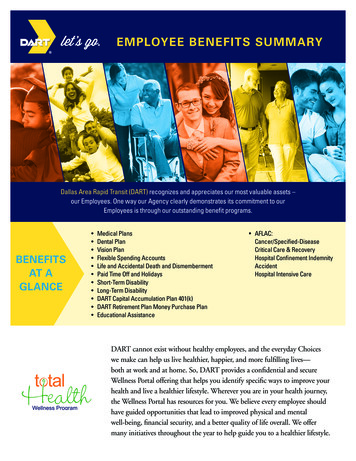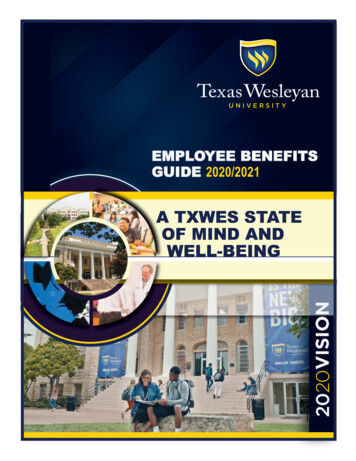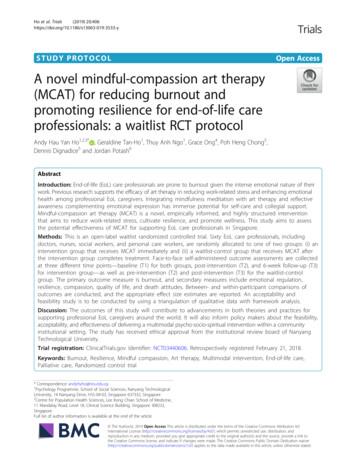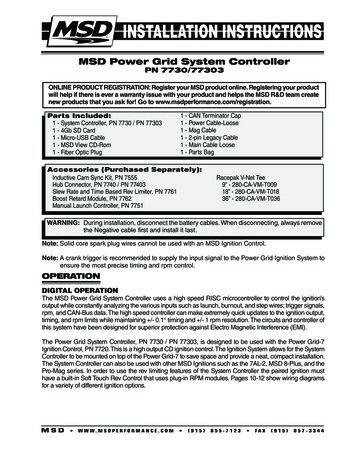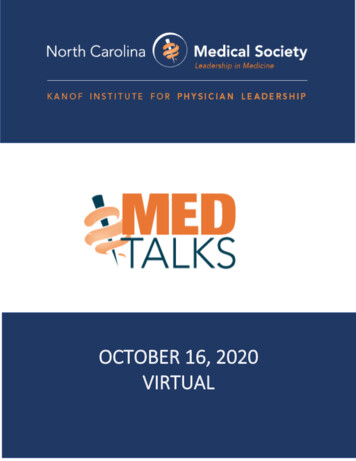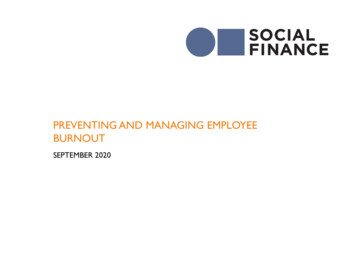
Transcription
PREVENTING AND MANAGING EMPLOYEEBURNOUTSEPTEMBER 2020
These materials were prepared as part of the Rapid Response Network, a jointinitiative between the California Mental Health Services Oversight andAccountability Commission (MHSOAC) and Social Finance, Inc. to supportjurisdictions in fast-paced research and decision making driven by COVID-19.The network aims to facilitate connections among jurisdictions facing similar challenges,and to supplement that shared experience with support from external experts—in order todeliver fast, customized, digestible research and analysis that strengthens local capacity.We recognize that the pace of these responses means that they are likely to be bothincomplete and imperfect. If you have suggestions for improvement or questions aboutthese materials, we would love to hear from you. Please email Jake Segal(jsegal@socialfinance.org) or Nic Miragliuolo (nmiragliuolo@socialfinance.org).With gratitude for the support of the Robert Wood Johnson Foundation and invaluable inkind support from GLG, which supports the RRN through access to their expert network.2Social Finance, Inc. 2020 Confidential
TABLE OF CONTENTSExecutive Summary (slide 4)Preventing Burnout: An overview (slides 5-10): Defining burnout and the associated challenges Strategies to prevent burnoutSupporting employees with children (slides 11-15): Associated challenges for working parents Reducing burnout for employees with childrenAdapting to new work arrangements (slides 16-17)Next steps (slides 18-20)More resources (slide 21)Sources (slide 22)Appendix (slide 23)3Social Finance, Inc. 2020 Confidential
EXECUTIVE SUMMARYSummarized from research literature and expert interviews Use assessments and screenings to understand the root causes Address factors that increase work-related stress: workload, control,Preventing burnoutreward, community fairness, and values Prevention is cheaper and more effective than treatment A continuous improvement process, not a one-time intervention Employees with children face increase in domestic work, difficulty inAdded challengesfor employees withschool-agedchildrenAdjusting to remote/ flexible workarrangements finding childcare, and increased mental loadCost-effective strategies include empathetic communication, supportgroups, flexible hours, and adjusted performance reviewsHigh-impact, higher-cost strategies include childcare support andincreasing PTO Embracing a flexible work schedule requires clear expectations thatexplicitly address problems, communication hours, and principles Employers can provide additional remote-work support such asreimbursements for WFH expenses and organized social activities4Social Finance, Inc. 2020 Confidential
PREVENTING BURNOUT: AN OVERVIEW5Social Finance, Inc. 2020 Confidential
FACTORS THAT CAUSE JOB BURNOUT“If you take a beautiful plant and put it in a lousy pot with no soil, no water, and no sun nomatter how good that plant was to start it’s not going to thrive”– Dr. Christine MaslachJob-Person Fit1Effect of COVID on these FactorsWorkload: Match between job demands and having theresources needed to meet those demandsUnsustainable Workload: Frontline workers must contendwith the increased health risk, challenging in-person workenvironment, and increased vulnerability of their clienteleControl: How much autonomy a person has in their work tofigure how to complete their workChoice and Control: Workers may feel a loss of control asthey must adjust to new schedules, new workenvironments, and other disruptions in their personal livesReward: Typically regarded as salary, benefits, and otherperks. But research has shown that social rewards are justas valuableRecognition and Reward: There may be a decrease ininformal positive feedback due to remote workCommunity: Does a person have good relationships atwork with their colleagues, boss, and clients?Supportive Work Community: Due to remote work,employees might feel isolated without regular daily contactwith coworkersFairness: Are organizational policies and practicesadministered fairly or must employees navigate gender,racial, or other forms of inequity?Fairness, Respect, & Social Justice: Employees may befeeling differential impacts of the COVID crisis on their lives,yet workplace policies may not have adjusted meet theseemployees’ needsValues: Does the work have meaning for the employee;often turns out to be one of the most important valuesClear Values and Meaningful Work: Will have significantvariance based on job category. Some workers may findtheir work more meaningful during COVID, some less soAll footnotes herein refer to references listed within Slide 23, References6Social Finance, Inc. 2020 Confidential
THREE DIMENSIONS OF BURNOUTThe Masalach Burnout Inventory (MBI) measures burnout across three dimensionsyielding different burnout profiles1“Burnout is a prolonged response to chronic stressors on the job” – Dr. Christine MasalachExhaustionIndividual stress brought on byoverwork. Workers with highnegative scores for exhaustiononly are overextendedProfessionalInefficacyCynicismNegative response to work.Workers with high negativescores for cynicism only aredisengagedNegative self-evaluation.Workers with high negativescores for inefficacy only areineffectiveWorkers with high negative scores on all three dimensions are identified as experiencing burnoutEmployees who are experiencing burnout are2: 63% more likely to take a sickday 23% more likely to visit theemergency room 50% as likely to discussperformance goals with theirmanager 13% less confident in theirperformance 2.6 times more likely to leavecurrent employerAll footnotes herein refer to references listed within Slide 23, References7Social Finance, Inc. 2020 Confidential
FRAMEWORK FOR PSYCHOSOCIAL RISK MANAGEMENTEuropean model for psychosocial health risks in the workplace3Co-creation: Thisframework requires theactive participation ofboth management andemployeesDevelopment of Action PlanRisk AssessmentAudit of existingpractices1Action plans should include what risk isbeing targeted, how, who is responsible,who else needs to be involved, timing,resources needed, expected benefits, howto measure benefits, and an evaluation2plan43OrganizationLearningUsing data collected from surveys andinterviews the assessment should ID theworkplace’s psychosocial risks and thenassess the harm caused by these risksEvaluation of ActionPlanPart of a process of continuous improvement,the evaluation should track both the process ofimplementation and well as the outcomes ofimplementation. The evaluation is meant todetermine how to improve future action plansRisk ReductionImplementation of action plan that ismonitored, measured, and evaluated tosee if and where corrective action mightbe needed“Best practice in relation to psychosocial risk management essentially reflects best practice in terms oforganizational management, learning and development, social responsibility and the promotion of quality of life”All footnotes herein refer to references listed within Slide 23, ReferencesSocial Finance, Inc. 2020 Confidential8
TRADITIONAL STRATEGIES TO PREVENT BURNOUTUtilize the design principles of ergonomics: creating custom-designed solutionsthat match the relationship between individuals and their work environmentTypes of Interventions3Root CausePrimary Prevention:ImpactManagementImpactReductionReducing work-related stressthrough changes in the waywork is organized includingSecondary Prevention:Development of individualskills in stress managementthrough trainingTertiary Prevention:development of rehabilitationand “return-to-work” systemsStrategy examples Workplace re-engineering: assessing what the workplace is like for theworkforce, and re-designing in to allow the workforce to be more efficientby reducing waste and removing barriers to success Implementing and improving communications systems Wellness programs, including trainings on relaxation and timemanagement Knowledge building and trainings on the causes and impacts of workrelated stress4 “Return-to-work”: Programs designed to address the impact of work-relatedinjury, including stress, and are designed the support the employee as theyreturn to their job Employee Assistance Programs (EAPs): Third party work-based programsthat offer screenings, short-term counseling, and follow-up services to assistemotional well-being challenges9All footnotes herein refer to references listed within Slide 23, ReferencesSocial Finance, Inc. 2020 Confidential
PREVENTING BURNOUT: CASE STUDIESSuccessful jurisdictions identified challenges, created customized action plans,and evaluated the impact of those plans1JurisdictionImplementation Issues an RFP for tools that would increaseemployee engagement and partnered withMeQuilibrium High suicide rate among staff High utilization of stress-relatedservices provided by health plan ½ day Mental Health First Aid training forsupervisors to increase EAP usageNeeded a deeper analysis of theroot causes of employee stress Improved communications on mental healthby hosting a community dialogue event andthrough the Healthy Saint Paul Newsletter Rate of depression in workforce 2%higher than in comparablegovernment jurisdictions Increasing rate of disability claimsand requests for workplaceaccommodations Benefits program had poor “returnto-work” programming and EAP hadlow usage rates Based on high rates of online usage of thecounty’s mental health screening tool, thecounty added a web-based interface for theirEAP programWorked with Behavioral Medical Interventionsand NAMI to develop a training program forsupervisorsCreated a return-to-work program throughtheir disability benefits vendor using on-sitecase managers Jurisdictions used key metrics toidentify workplace mental healthchallenges Current tools had low usage ratesCity ofSt. Paul5HennepinCounty52AssessmentThemes Reduced barriers to using current tools byincreasing communications frequency andadded in-person support and online access tothose tools Partnered with experts to develop trainingsfor supervisorsAll footnotes herein refer to references listed within Slide 23, References3Outcomes Still too early to measureoutcomes; usage rates of EAP andMeQuilibrium are key metrics It’s OK to spend first year focusedon educating workforce on mentalhealth Focused on co-morbidities asindividuals already engaged withhealth system should also havetheir mental health assessed ROI of 81 to 1 compared to thedisability insurance industrystandard of 27 to 1 for similarpreventative case managementprograms Assessment and education arecrucial during earlyimplementation Focus on high risk individuals Significant benefit to the employer10Social Finance, Inc. 2020 Confidential
SUPPORTING EMPLOYEES WITH CHILDREN11Social Finance, Inc. 2020 Confidential
SUPPORT NEEDS TO ADDRESS PARENT-EMPLOYEE CHALLENGESParents can face more stress and be less productive due to caregiving rolesChallengesIncrease indomesticworkOutcomes A BCG study found that parents spend approximately 50%more time on education and household work now thanprior COVID-196 Of this increased time, women spend 30% more time ondomestic work than men6 Less time for workand leisure Decreasedproductivity dueto less sleepCOVID-19 regulations make it difficult to find care6,7: Daycare/schools are remote or at reduced capacity Children are often unable to attend daycare/school inFinding Child person if they experience any COVID-19 symptoms,Careleading to an unpredictable childcare schedule Increased costs inchildcare Increased PTOused Increased stressThe average stress level for parents during COVID-19 is 12% higher than non-parents due to these stressors6,8: Personal and children’s health Children’s education (distance learning, education quality) Personal performance at workMental Load Unpredictable routines Basic needs (access to food, housing, etc.) Increased stressand anxiety Decreasedproductivity andcapacityAll footnotes herein refer to references listed within Slide 23, References12Social Finance, Inc. 2020 Confidential
STRATEGIES TO SUPPORT EMPLOYEES WITH CHILDREN (1/2)Low-resource solutions to prevent and manage burnout1Empathetic andtransparentcommunication6,7,9To reduce feeling of isolation andanxiety around employer support, jobloss, and performance challenges1.2.Proactively reach out toparent employees tounderstand andacknowledge the challengesEstablish that this is acommunity responsibility,not an individual’sCushman and Wakefield9 Weekly check-ins from supervisors Communication from leadership toconnect and share solutions Impact: improved sense ofcommunity, reduced anxietyCreate ParentAffinity Groups5,10, 112Parents can learn from and gainsupport from those facing similarchallenges1.2. Formal support groups:educational program,scheduled monthly, andfacilitated externallyInformal affinity groups:group: instant messaginggroup to share resources andengage with each other’s kidsClackamas County5Monthly caregiver support groups6-week program: Tools for CaregiversEducational offerings on how tocope, care for one’s own needs, etc.Impact: Stronger caregiver skills,reduced absenteeismAll footnotes herein refer to references listed within Slide 23, ReferencesAdjust workinghours6,7,113With children at home, parents need toperform caretaker responsibilitiesduring the traditional 9-5 workday1.Flexible hours: employeescan work when they need tofit their caretaking schedule2.Reduce hours/decreaseworkload to compensate forincrease in household work3.Offer company-wide breaks(e.g. lunch, afternoon)Skyscanner Instituted a company-wide 3-hourbreak in the afternoon Impact: allows employees to takecare of their children withoutworrying about work performance13Social Finance, Inc. 2020 Confidential
STRATEGIES TO SUPPORT EMPLOYEES WITH CHILDREN (2/2)High-impact, high-resource solutions to prevent and manage burnoutChange employeeperformancereviews6Support ChildCare6,7,10,114Supporting childcare reduces stress,hours spent on domestic work, childcareexpenses, and increases productivity1.Provide reimbursements/subsidies for childcareexpenses2.Organize study pods with agroup of employee children( 10-15 per child per hour7)3.Utilize vacant office space toprovide daycare/school foremployee’s children5Parents have less time for work and/orsleep, which may impact theirperformance at work1. Establish a plan that factorsthe impact of childcare intotalent evaluations and trackimpact Notation of impactIncrease PTO5,6,116Unexpected childcare responsibilities orthe inability to find backup childcareincreases the need for time off work1.Formal PTO programs: fullypaid, partially paid, or unpaidleave with benefits2.Unexpected childcare PTOfor when parents cannot findbackup childcare3.Respite care: encourage timeoff for self/family care andhelp employees find costeffective solutions Adjustment of annual goals Longer term performancetrends and future potential Employee protection againstretaliationUnited Health System10 Onsite daycare facilities for employee children aged0-12 35-65 per child, per day Impact: reduced childcare hours for parents andessential employees could return to work in-personHome Depot9 10 days subsidized backup care 2 weeks paid leave (COVID related, including forchildcare) Impact: reduced mental load, increased time forrest, improved morale14All footnotes herein refer to references listed within Slide 23, ReferencesSocial Finance, Inc. 2020 Confidential
CASE STUDY: CAREGIVER PROGRAM IN CLACKAMAS COUNTY, ORCounty caregiver program supports employees balance work and caregiving Employer: Clackamas County, Oregon Number of employees: 2,100 Problem: Increase in employees retiring early or reducing work hours to care foraging parents; county wanted to support employees balance work and caregiving51AssessmentA. Reviewed internal data: Exit interview data Use of county’s EAP Wellness Assessment survey Data specific to the FMLAB. Reviewed national data toderive stronger insights: EEOC and National Alliance forCaregiving data indicatedcounty employees mirrored atypical caregiver profile Used as a proxy to estimatethe percentage of employeecaregivers and absenteeismcosts2Implementation Interagency agreement wasbuilt to create DHS-SSD Agencyon Aging Program Population Services at no cost toemployees: 6 sessions to improve personaladvocacy Monthly support groups Individualized information andreferral services 6-week educational program:Powerful Tools for Caregivers Library of resources Helps employees find costeffective respite care3Outcomes Reduction in employeeabsences Improved caregiving abilities,such as stronger skills to solvechallenging caregiving issues Participation of caregivingservices was slow initially, butincreased by 50% within twoyearsSimilar to working parents during COVID-19, caregivers experience high levels of burnout – they experience stress,anxiety, and depression from lack of self-care/downtime, limited awareness of resources, and feelings of isolation.5Notes: (A) EAP: Employee Assistance Program (B) FMLA: Family and Medical Leave Act (C) EEOC: US Equal Employment Opportunity CommissionAll sources herein refer to references listed within Slide 23, ReferencesSocial Finance, Inc. 2020 Confidential15
ADAPTING TO NEW WORK ARRANGEMENTS16Social Finance, Inc. 2020 Confidential
SUPPORTING EMPLOYEES TO ADJUSTEmbrace flexibility, but define clear guidelines around work expectationsCommunications GuidelinesExplicitly address theproblems10,12Set clear communicationhours12Establish principles forcommunication channels12 Acknowledge the issues of aremote/flexible arrangement Emphasize importance ofdowntime & developingroutines Flexible hours can create an“always on” culture The expectation of beingavailable “after hours” causesstress and anxiety11 Unclear expectations canprevent employee’s managingattention, decreasingproductivity10Potential actions: Host regular “town halls” Institute regular check-insbetween supervisors andemployees about WFHarrangements, mentalhealth, capacityPotential actions: Define communicationhours (e.g. 8am -5pm) Leadership must follow thepolicies (don’t rewardcommunication outsidehours)Potential actions: Email: Routine requests,information sharing Instant messaging: Day-today notes, socializing Phone, video calls:Sensitive/complex topics Texts: Urgent onlyRemote work tools and supportsImprove the work-from-home environment9,10 Offer reimbursements for work-from-home expenses (e.g. internet, headphones, etc.) Organize social activities to build an engaged workforce (e.g. trivia game, water cooler chats, happyhours, etc.)All footnotes herein refer to references listed within Slide 23, References17Social Finance, Inc. 2020 Confidential
NEXT STEPS AND RESOURCES18Social Finance, Inc. 2020 Confidential
POTENTIAL NEXT STEPS TO PREVENT AND MANAGE BURNOUTFor consideration based on the research1Assessment: Using both qualitative (focus groups) and quantitative (surveys) methods, determinewhat aspects of the work environment are causing employee burnout2Develop Action Plan: Using the assessment develop a strategy to address employee burnout. Thisstrategy should include resources needed; employee segment being targeted (i.e. working parents);and primary, secondary, and tertiary tactics.3Implement and Iterate: Roll-out action plan, and use employee and supervisor feedback to iterateand adjust the action plan.4Evaluate and re-assess: Measure outcomes and use evaluation of action plan as an opportunity fororganizational learning and growth19Social Finance, Inc. 2020 Confidential
CONSIDER PRIORITIZING BURNOUT PREVENTION STRATEGIESPlace potential strategies in consultation with management teamStrategy Key31Manager-employee check-ins2Employee Assistance Programs3Workplace re-engineering4Wellness Programs5Supervisor trainings on employeemental health6Childcare reimbursement orsubsidies7Study pods8On-site day care9Childcare focused PTO programs10Flexible Hours11Changes to workload1212Company wide-breaks1513Improved communication14Affinity Groups15Adjust Performance Review System5Impact on Workforce131811614107249Cost of Intervention20Social Finance, Inc. 2020 Confidential
HIGH-VALUE RESOURCES ON EMPLOYEE BURNOUTTypeResource LinkAssessmentMasalach Burnout InventoryFramework (video)Understanding Job Burnout - Dr. Christina MaslachEmployee health and theworkplace (book)Jeffery Pfeffer: Dying for a PaycheckEmployer ResourcesCenter for Workplace Mental HealthToolsMindwiseToolsBerkeley Interdisciplinary Center for HealthWorkplaces21Social Finance, Inc. 2020 Confidential
REFERENCESBelow resources are referenced in preceding slides by footnotesSOURCE#1World Psychiatry(Christina Maslach and Michael P. Leiter)LINKUnderstanding the burnout experience: recent research and its implications for psychiatry2GallupEmployee Burnout, Part 1: The 5 Main Causes3World Health OrganizationPRIMA-EF: Guidance on the European Framework for Psychosocial Risk Management4World Health OrganizationBest Practice in Work-related Stress Management Interventions5American Psychiatric AssociationCenter for Workplace Mental Health: Case Studies6Boston Consulting Group (BCG)Easing the COVID-19 Burden on Working Parents7SHRMAccommodating Working Parents During the COVID-19 Pandemic, Exhausted Parents GetHelp from Employers8American Psychological AssociationStress in the Time of COVID-19910111213Miriam Brilleman, Senior Director of HumanResources at Cushman & WakefieldCorey Heller, Head of HR Business Partners andShared Services at United Health SystemThe New York TimesHarvard Business Review(Maura Thomas)Virginia TechN/AN/APrivate Tutors, Pop-Up Schools or Nothing at All: How Employers Are Helping ParentsThe Downside of Flex Time, Protecting Company Culture Means Having Rules for EmailKilling Me Softly: Electronic Communication Monitoring and Employee and Spouse Well-Being22Social Finance, Inc. 2020 Confidential
ADDITIONAL EXPERTS CONSULTED Miriam Brilleman, Senior Director of Human Resources at Cushman &Wakefield, Inc. Juana Scholes, Director of Human Resources at Aldridge Pite Llp Corey Heller, Head of HR Business Partners and Shared Services atUnited Health System Inc.23Social Finance, Inc. 2020 Confidential
injury, including stress, and are designed the support the employee as they return to their job Employee Assistance Programs (EAPs): Third party work-based programs that offer screenings, short-term counseling, and follow-up services to assist emotional well-being challenges Wellness programs, including trainings on relaxation and time-
